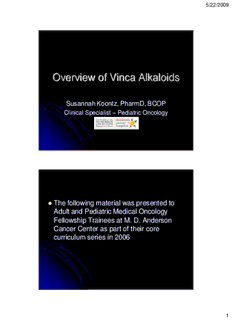
Overview of Vinca Alkaloids (2006) - Koontzoncology.com PDF
Preview Overview of Vinca Alkaloids (2006) - Koontzoncology.com
5/22/2009 Overview of Vinca Alkaloids Susannah Koontz, PharmD, BCOP Clinical Specialist – Pediatric Oncology The following material was presented to Adult and Pediatric Medical Oncology Fellowship Trainees at M. D. Anderson Cancer Center as part of their core curriculum series in 2006 1 5/22/2009 Introduction & History Extracts of the periwinkle plant (Catharanthus roseus – formerly known as Vinca rosea) Introduction & History The French referred to it as “violet of the sorcerers” Early uses Scurvy Toothaches Controlling hemorrhage Diabetes – investigated as a hypoglycemic agent by Eli Lily 2 5/22/2009 Introduction & History Anticancer activity first noted in 1957 in rats (Bone marrow suppression and antileukemic effects) Cytotoxicity activity occurs through the disruption of microtubules Introduction & History US commercially available agents Vincristine (Oncovin®) Vinblastine (Velban®) Vinorelbine (Nalvelbine®) US investigational agents Liposomal vincristine (Marqibo®) Vindesine (Eldisine®) 3 5/22/2009 Structures and Chemistry Two linked components Dihydroindole nucleus = Vindoline Indole nucleus = Catharanthine Linked by carbon-carbon bond Structures and Chemistry 4 5/22/2009 Microtubules Integral components of mitotic spindle Composed of tubulin with each heterodimer consisting of 2 subunits – α- and β-tubulin Tubulin molecules assemble into microtubules by forming linear protofilaments Microtubules are composed of 13 protofilaments aligned side-by-side around a hollow core with α- and β-tubulin subunits alternating with each other Microtubules 5 5/22/2009 Microtubules Microtubule is in dynamic equilibrium between assembly and disassembly Cellular functions Neurotransmission Mitosis Polymerized tubulin can be modified and can serve as binding sites for microtubule associated protein (MAP) Stabilize microtubules against disassembly Mechanism of Action Inhibition of microtubule assembly through tubulin interaction and disruption Specific for M phase Correlations have been made between cytotoxicity and dissolution of mitotic spindles 6 5/22/2009 Mechanism of Action Drug concentration and exposure Concentration that inhibits cell proliferation is directly related to concentration that induces metaphase arrest in 50% of cells Low concentrations stabilize microtubule length and leads to inhibition of mitosis High concentrations disruption of microtubules Duration of drug exposure above a specific threshold may be most important factor for cytotoxicity Mechanism of Action Other Disrupts structural integrity cells rich in tubulin as well as the cell membrane and functions Induces morphological changes in cells during G1 and S phases Competes for transport of amino acids into cells Inhibits purine biosynthesis Inhibits RNA, DNA and protein synthesis by blocking glutamic acid utilization Inhibits angiogenesis 7 5/22/2009 Drug Resistance Related to decrease drug accumulation and retention within cells Two main types of resistance Multidrug resistance Alterations in tubulin proteins Drug Resistance Multidrug resistance (MDR) Overexpression of mdr-1 gene P-glycoprotein (Pgp) works as an energy dependent efflux pump Drug resistance ~ [Pgp] In vitro reversal of inhibition by calcium channel blockers, antihypertensives, antiarrhythmics, antibiotics, and cyclosporine 8 5/22/2009 Drug Resistance Alterations in α- and β-tubulin proteins Results in decreased drug binding or increase resistance to microtubule disassembly Overexpression of β-III isotype of β-tubulin Decreased binding affinity of tubulin for alkaloids FDA-Approved Indications Vincristine ALL (Hyper-CVAD) NHL (CHOP) Hodgkin’s Lymphoma (MOPP) Neuroblastoma Rhabdomyosarcoma Wilms’ Tumor 9 5/22/2009 FDA-Approved Indications Vinblastine Testicular Hodgkin’s Lymphoma (ABVD) NHL Breast Choriocarcinoma Malignant histiocytosis Mycosis fungiodes Kaposi’s sarcoma FDA-Approved Indications Vinorelbine NSCLC 10
Description: